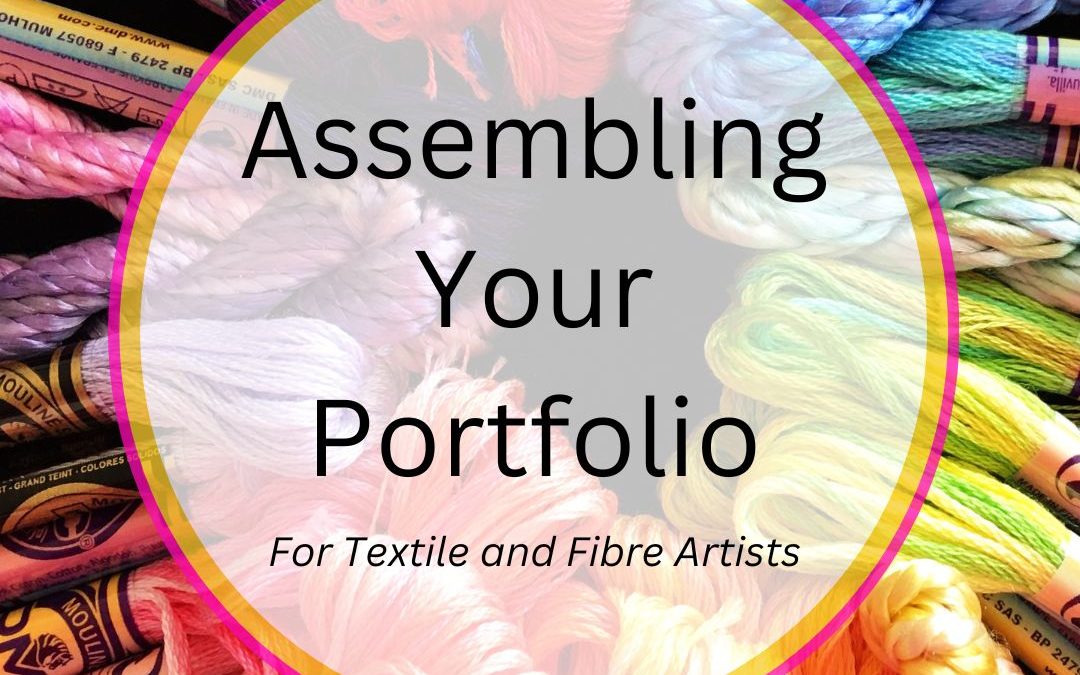A portfolio for textile and fibre artists?
Yes, absolutely.
Why do you need one and how do you assemble it?
I think the why is obvious – to broaden your artistic identity through gallery exhibitions, submissions to magazines, teaching workshops at specialized events, grant and artist-in-residence submissions, enticing collectors or even offering to do presentation work.
Year by year, I see further recognition and value being placed on the textile and fibre arts, so this is a way to keep pace with demand.
In this digital age, organizing a portfolio is not as difficult as it sounds – and if you’re an organized artist, with images of all your past and current work, as well as an up-to-date short bio, artist statement, resume, and head-shot neatly filed away and easily accessible, this may only take you a couple of hours or so.
And don’t forget to add links to your website and social media platforms, along with your contact information.
If this isn’t the case, then perhaps it’s time to address these issues, because if you have a portfolio ready at your fingertips then you’re able to email this power-packed information to galleries who might be interested in showing your work, collectors interested in buying your work, organizations who may be willing to employ you to teach or speak, grant or artist-in-residence submissions, or to provide magazine editors a glimpse into your very special and unique style of work – all at the press of one tiny little button.
New galleries are always popping up, magazines are always on the lookout for new talent, specialized craft events want a diversity of teachers and speakers, and collectors are always on the lookout for new acquisitions.
And you may just be their perfect fit.
If you’re not so confident in fronting up to a Gallery, editor, or craft group in person, this is a good solution to the problem – plus it gives people time to really look at your work as well as your personal information, to see if you’ll be a good fit for them.
And don’t be distraught if their responses are not what you want to hear – just keep trying and remain strong.
So, in simple point form, here are my suggestions for building your very own portfolio:
- include work that’s consistent, harmonious, and unified, that focuses on one theme, one medium and one technique showing a clear narrative for the topic you’re exploring
- if you work with multiple materials, techniques, and themes, then it might be an idea to produce a portfolio for each one
- include your best, most current work
- include images of some of your sold pieces – just to support your artistic credibility
- if you’ve exhibited before, include a few images of installed works to show the diversity of hanging, display, and orientation
- also include some work-in-progress images, showing where and how you work, just for added interest
- submit images of your art first, followed by your bio, resume, artist statement, contact details, and a recent professional headshot
- remember to do your research – not all events, magazines, or galleries will be suitable for you and vice-versa, so check them out first to see if you’ll be a good fit with them and the work they carry or promote
- and if you’re selling your work, price it competitively – and I know pricing is never easy – in this area of artistic endeavour there’s no way pricing on a sliding size scale or by the hour will work, it has to be reflective of a value people are willing to invest in you and your abilities as an artist
- remember this is something that needs to be updated annually to reflect new work and new applications of technique
- here are three websites to help you begin your research
Now that’s not really so hard.
It may be a great exercise to do even if you don’t use it, but I hope you do because we need to see new creativity and innovation in the textile and fibre arts along with a certain level of professionalism, and that can only happen if you’re willing to show your work, teach, go after grants and residencies or make yourself available for magazine articles.
Plus it’s a great way to value-add to our wonderful world of textiles and fibre art.
Good luck assembling your very own portfolio.

All views and opinions expressed are my own, except where acknowledged information is included from other sources.

